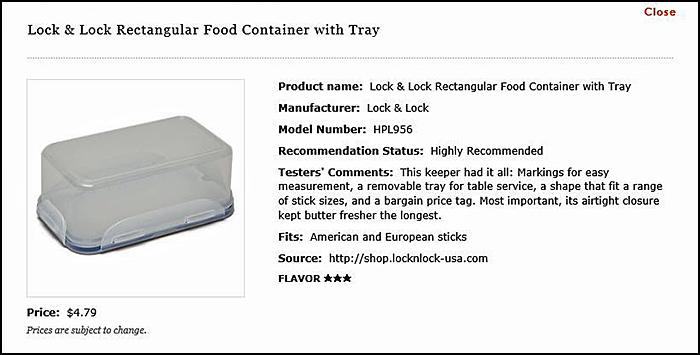-
Posts
4,804 -
Joined
Content Type
Profiles
Forums
Store
Help Articles
Everything posted by Shel_B
-
This one was the winner in the Cook's Illustrated test of butter dishes. Amongst it's attributes is the ability to hold large, European-style, blocks of butter and the butter tray is removable.. Not very stylish, but certainly practical:
-
Just following up on this. Last week I stopped into a supermarket that had the Ziploc containers, and right next to them on the shelf were some similar store brand units. The store brand had a size closer to what I was looking for, and I bought a package of three. On the way to the register I saw some really inexpensive aluminum loaf pans (like these: http://www.apartysource.com/al-16.html), and they were even closer to the size I wanted, so I bought three. Both are installed in the cupboard, and the aluminum loaf pans have turned out to be the best option. So, I'm all set. Thanks to all who jumped in with ideas and suggestions.
-
I've never heard of those noodles ... I'll have to look for them. They sound much better than the supermarket fried ramen packages. Thanks for posting!
-
I've not seen this one before. Is it new? Has anyone tried it? http://www.thermoworks.com/products/handheld/temptest1.html Perhaps it should be mentioned that I'm thinking of getting this as a gift for someone, and it looks like it has all the good features of the Thermapen with backlight plus a couple, and it's about $25.00 less expensive.
-
Just a quick observation here ... recently I purchased a bag of Christopher's Ranch peeled garlic at Costco. There were quite a few small cloves in the bag - small enough to make grating them with the Microplane difficult - and very few large cloves. A nice feature of the bagged garlic is that none of the cloves we used had a green shoot in the center.
-
Thanks for all the feedback ... doesn't look like I'll go there.
-
Does anyone use them? How do they compare in efficiency and feel to standard whisks? Any downside that you know of?
-
Thanks for the commentary. I'll have to measure the height of my Waring, and check the weight as well.
-
-
You've provided some "food for thought." There are no vegetables other than peppers and tomatillos in my chile verde,
-
Hi, Shelby - if you'd eat it why not serve it to your guests?
-
At the end of this month there will be two dinners that I'll be preparing. One is a potluck and the other, five days later, is dinner at home with a couple of friends. I was thinking of making a double/triple batch of my chile verde, and am wondering the best way to store the stew for the five-six days necessary. I know stews often are better after a day or so, but what about after five or six days? If I freeze the second batch, how might that effect the texture of the meat. I've never stored my chile verde for more than a day. I am hoping that I can just store the second batch in the fridge in a covered bowl for five days or so. That would make my life very much easier. Thoughts?
-
Host's note: the term 'new discussion' refers to a second topic, which has since been merged with the original. And this new discussion brings me to a question: How might duck fat work instead of schmaltz when making a traditional chopped liver dish (using chicken livers)? Seems like it should be just fine. Anyone tried it?
-
It's not at all tedious. The beans will have been soaking in the rum for a while, so all I have to do is scrape the beans into the mixture, just as always. I already know I can add straight rum to the custard ... no big deal. This technique is new to me, so I may learn something, get a great result, or flop. Sometimes it's the journey, not just the destination.
-
I've already got a bottle of dark rum, so that's covered. Nutmeg or Allspice ... OK, I'll test those with the rum. Tks!
-
I like to try making a rum flavored custard. The plan is to infuse the vanilla beans with dark rum, and hope that I'll get a little rum flavor into the custard. Just to be clear, I'm looking for subtle flavor, not a hit-you-in-the-face rum attack. Any thoughts on this idea? Secondly what spice flavor might go with the rum? I've been lightly grating nutmeg over my custards, but with the rum flavor, might there be a more interesting spice? Maybe allspice, or mace? Thanks!
-
I buy just about everything organic, and research, often through Cornucopia Institute - but not limited to them - the quality of the organic products I buy and use. I buy only top tier organics, and much of my shopping is done at the Berkeley Organic Farmers market, although I do buy a good amount of items at TJ's. There is very little waste it my place, and likewise at Toots'. If, between us, we toss a five gallon can into the landfill every couple of weeks, that's a lot, but El Cerrito has an EXCELLENT recycling program and produces compost from green waste which is distributed back into the community. Even plastic bags and containers are recycled. My cookware is all pretty efficient and is purchased with durability and long-term use in mind. As for cooking efficiency, well, I am able to break down my cost for electricity (which is what my stove, oven, etc., uses) into 15-minute increments, so I know exactly what it costs to boil an egg or sear a pork chop. Rarely do I use the oven, rather, I most often use the Breville Smart Oven unless I'm cooking a big meal and need the space the full-sized oven provides, but even then some items will often be cooked in the Breville. It cost me 44-cents to prepare New Years Eve dinner for Toots and myself. In the FWIW department, my electric bill runs about $5.00 per month. Recently the City of El Cerrito decided to offer Clean Energy to it's citizens through Marin Clean Energy, and by May just about all the energy I use will be clean energy, produced by renewable resources such as wind, solar, hydro, etc. Rarely do I have leftovers unless I cook with that purpose in mind. Rarely is any useable food put into the compost bin. When cooking at Toots' place we often cook with the idea of making leftovers, and more often than not those items can be given a quick zap in the microwave to heat up. We also grow some of our own produce - potatoes, leeks, tomatoes, herbs, peppers, squash ... all organic, often using the compost provided by the city that we helped to provide. There's that completed circle ... We both reuse plastic bags from the market, and I pretty much no longer store anything in plastic, using only glass containers for most everything, and the containers are, of course, reused. I am slowly drifting away from foods sold in cans, preferring those items sold in glass or canning my own. Admittedly, it's a slow process, but I am making progress. Toots cans a lot of fruit and has been teaching me some techniques. Overall, I think we are very conservative. I buy more high-end organics than Toots, but we both support local businesses as much as possible.
-
I have had a similar problem with my LC, and did a lot of research on how to clean the pot. Ultimately, I soaked the pot in a mild solution of hot water and bleach with a little detergent added. After an hour or so I rinsed the pot well, washing with hot, soapy (Dawn dish washing liquid) water until clean. That solved the problem. I would not use any abrasive, even Bon Ami, on the enamel. If I recall correctly, LC suggests not using an abrasive, and recommended the bleach-soapy water method. CAVEAT: Your problem appears similar to, not the same as, my problem. In my case I left the pot on a hot burner and, for lack of a better description, burnt some food and residue into / onto the enamel. I did not try any other approaches, such as cleanser, Bon Ami, etc., before using the bleach technique. I used the technique on my older (40+ years) LC, so the enamel may be slightly different than the newer, cream colored enamel, although LC says they will both respond well to the described technique. YMMV ... Good Luck.




